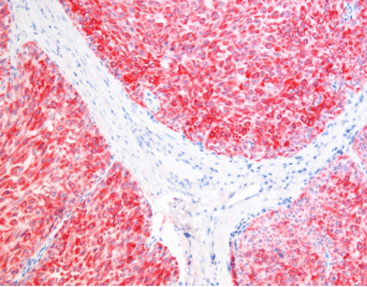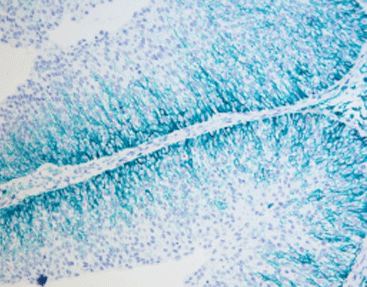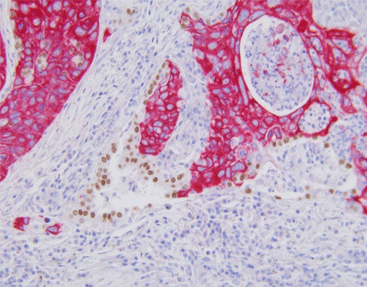Exploring the Benefits of Multiplex Immunohistochemistry Over Conventional IHC

By admin
Background to Multiplex Immunohistochemistry
What is Multiplex IHC
Multiplex immunohistochemistry (multiplex IHC or mIHC) is an advanced staining technique that allows simultaneous detection of multiple biomarkers on a single tissue section. It allows researchers to visualize complex interactions between various cell types and proteins in their natural spatial context.
How It Differs from Conventional IHC
Traditional IHC typically permits one or two marker staining on a slide, and serial sections are often required to examine multiple targets. Multiplex IHC utilizes tyramide signal amplification (TSA) and antibody stripping techniques to stain multiple antigens on the same tissue section without cross-reacting. The performance, combined with our reagent consistency, ensures reproducibility of results and long-term fluorescence stability.
Key Advantages of Multiplex IHC
Concurrent Detection of Multiple Markers
The most significant benefit of multiplex IHC is the ability to concurrently detect several biomarkers using different fluorophores or chromogens. It provides an overall perspective of the cell surroundings and interactions without requiring additional tissue samples.
Better Tissue Context and Spatial Resolution
Multiplex IHC preserves the spatial relationship between cells and molecules, which is extremely significant in tumor microenvironment studies and immune cell infiltration pattern research. Through multi-color immunohistochemistry staining, the spatial relationship among different antigens is more straightforward, which is conducive to improving the detection rate of tumor microinfiltration and improving the accuracy of pathologic diagnosis.
Less Sample Consumption
As all markers are displayed on one slide, multiplex IHC minimizes the quantity of tissue needed—a characteristic invaluable when working with limited biopsy tissue such as fine-needle aspirates or core biopsies.
Research and Diagnostic Practical Applications
Analysis of Tumor Microenvironment
Multiplex IHC is an essential tool in cancer research because it enables extensive visualization of tumor morphology, stromal components, and immune cell distribution—all of which are important factors in therapeutic response evaluation.
Immune Cell Profiling
Researchers are able to profile immune cells like T cells (CD3+), B cells (CD20+), macrophages, and dendritic cells simultaneously on one slide to understand immune landscapes in diseases like cancer or autoimmune diseases.
Biomarker Validation
By enabling direct comparison between multiple protein expressions within the same tissue context, multiplex IHC serves as an ideal platform for validating novel biomarkers before clinical deployment.
Celnovte’s Multiplex IHC Product Line
Celnovte offers a robust suite of multiplex immunohistochemistry reagents tailored for high-performance imaging across various research applications.
Celnovte Basic Dark Red Stain Reagent Kit
Designed for chromogenic detection, this reagent kit provides rich dark-red staining ideal for dual- or triple-color assays where contrast between markers is essential.
Celnovte HRP-Green Stain Reagent Kit
This kit delivers clear green chromogenic signals using horseradish peroxidase (HRP), suitable for low-background environments and compatible with other colorimetric stains in multi-target panels.
Celnovte CK5/6/TTF-1 Detection Reagent
This specialized reagent targets cytokeratin 5/6 and thyroid transcription factor-1—two crucial markers in lung cancer diagnostics—allowing precise identification on a single slide without compromising specificity or sensitivity.
The CNT multiplex immunofluorescence (mIHC) kit offers an adaptable and high-performance solution for researchers looking to achieve clear, multi-channel staining results.
Workflow Optimization with Celnovte Solutions
Simplified Protocols and Reagent Compatibility
Celnovte’s mIHC kits are designed to integrate seamlessly into existing workflows with minimal protocol changes compared to established systems like Akoya Opal. Through careful protocol design, we have ensured minimal differences between our process and established systems like Akoya Opal, making it easy for users to adopt our product with minimal workflow disruption.
Each kit includes pre-optimized reagents compatible with common antigen retrieval methods, enzyme-labeled polymers, TSA dyes such as CM480 through CM780 series, and DAPI nuclear counterstaining solutions.
Cost and Time Efficiency in Standard Labs
With more efficient protocols reducing hands-on time per cycle and fewer slides required per case, labs can significantly reduce cost while increasing throughput—especially useful for high-throughput diagnostic centers.
Using this guide, users can seamlessly integrate CNT’s mIHC solutions into existing immunostaining procedures, with or without the use of automated platforms like Leica Bond RX or manual staining techniques.
Comparing Results: Multiplex vs Conventional IHC
Quantitative vs Qualitative Analysis
Conventional IHC provides only qualitative output based on visual inspection, but multiplex IHC has the ability to yield quantitative image analysis based on computer software assessing fluorescence intensity per marker channel within defined areas.
The comparative research identifies that CNT’s mIHC kit always yields higher signal intensities, better signal-to-noise ratios, and clear-cut biomarker localization.
Consistency and Reproducibility Across Samples
Due to reduced variability induced by sequential sectioning or single slides per marker—e.g., using conventional techniques—multiplex techniques offer higher reproducibility among experiments.
Researchers can now feel comfortable expanding their staining capabilities, gaining more information about complex biological systems with greater precision.
For researchers seeking cutting-edge tools in multiplex immunohistochemistry that combine performance with ease-of-use, Celnovte offers an ideal solution backed by advanced R&D capabilities from Senot Biotech—a leader in precision diagnostic technologies since 2010. To learn more about our products or place an order, visit shop.celnovte.com or contact us at info@celnovte.com / +1-617-416-7995.
FAQ
Q: What are the main differences between multiplex immunohistochemistry and conventional IHC?
A: Traditional IHC only identifies a single or two markers on a slide with the help of chromogenic substrates, while multiplex IHC allows simultaneous identification of multiple markers on a single slide using fluorophores or chromogens in combination with TSA amplification techniques.
Q: Is it possible to use Celnovte’s multiplex kits with available lab equipment?
A: Yes, users are able to simply adopt CNT’s mIHC solutions into their existing immunostaining workflows, both manual and automated platforms like Leica Bond RX.
Q: How does Celnovte ensure consistency across different batches?
A: All reagents are produced under strict GMP-compliant conditions with ISO9001/ISO13485 certifications, ensuring batch-to-batch consistency critical for reproducible research outcomes.
Q: What makes Celnovte’s mIHC kits stand out from competitors like Akoya Opal?
A: CNT’s mIHC kit consistently delivers stronger signal intensities, superior signal-to-noise ratios, clearer biomarker localization, especially in key channels such as CM480 and CM690—with minimal need for protocol adjustments compared to Akoya Opal systems.
RELATED PRODUCTS









